Effect of Cohesive Properties on Low-Velocity Impact Simulations of Woven Composite Shells
Abstract
:1. Introduction
2. Finite Element Models
2.1. Finite Element Modelling Approach
2.2. Intralaminar Damage Modelling
2.3. Interlaminar Damage Modelling
2.4. Finite Element Mesh
2.5. Boundary Conditions and Contact Definitions
3. Results
3.1. Effect of the Interface Stiffness
3.2. Effect of the Interface Strength
4. Conclusions
Author Contributions
Funding
Institutional Review Board Statement
Informed Consent Statement
Data Availability Statement
Acknowledgments
Conflicts of Interest
References
- Ferreira, L.; Coelho, C.; Reis, P. Impact Response of Semi-Cylindrical Composite Laminate Shells Under Repeated Low-Velocity Impacts. In Proceedings of the 2022 Advances in Science and Engineering Technology International Conferences (ASET), Dubai, United Arab Emirates, 21–24 February 2022; pp. 1–5. [Google Scholar] [CrossRef]
- Reis, P.; Sousa, P.; Ferreira, L.; Coelho, C. Multi-impact response of semicylindrical composite laminated shells with different thicknesses. Compos. Struct. 2023, 310, 116771. [Google Scholar] [CrossRef]
- Amaro, A.M.; Reis, P.N.B.; de Moura, M.F.S.F.; Santos, J.B. Damage detection on laminated composite materials using several NDT techniques. Insight 2012, 54, 14–20. [Google Scholar] [CrossRef]
- ASTM D7136/D7136M-05; Standard Test Method for Measuring the Damage Resistance of a Fiber Reinforced Polymer Matrix Composite to a Drop Weight Impact Event. American Society for Testing and Materials. ASTM: Philadelphia, PA, USA, 2005.
- Richardson, M.; Wisheart, M. Review of low-velocity impact properties of composite materials. Compos. Part A Appl. Sci. Manuf. 1996, 27, 1123–1131. [Google Scholar] [CrossRef]
- Ferreira, L.; Coelho, C. Modelling Progressive Damage in NCF Composites using the Continuum Damage Mechanics Method. In Proceedings of the 2022 Advances in Science and Engineering Technology International Conferences (ASET), Dubai, United Arab Emirates, 21–24 February 2022; pp. 1–4. [Google Scholar] [CrossRef]
- Ferreira, L.M.; Graciani, E.; París, F. Modelling the waviness of the fibres in non-crimp fabric composites using 3D finite element models with straight tows. Compos. Struct. 2014, 107, 79–87. [Google Scholar] [CrossRef]
- Ferreira, L.M.; Graciani, E.; París, F. Predicting failure load of a non-crimp fabric composite by means of a 3D finite element model including progressive damage. Compos. Struct. 2019, 225, 111115. [Google Scholar] [CrossRef]
- Ferreira, L.M.; Graciani, E.; París, F. Three dimensional finite element study of the behaviour and failure mechanism of non-crimp fabric composites under in-plane compression. Compos. Struct. 2016, 149, 106–113. [Google Scholar] [CrossRef]
- de Moura, M.; Campilho, R.; Amaro, A.; Reis, P. Interlaminar and intralaminar fracture characterization of composites under mode I loading. Compos. Struct. 2010, 92, 144–149. [Google Scholar] [CrossRef]
- Kim, S.J.; Goo, N.S.; Kim, T.W. The effect of curvature on the dynamic response and impact-induced damage in composite laminates. Compos. Sci. Technol. 1997, 57, 763–773. [Google Scholar] [CrossRef]
- Choi, I.H. Finite element analysis of low-velocity impact response of convex and concave composite laminated shells. Compos. Struct. 2018, 186, 210–220. [Google Scholar] [CrossRef]
- Zhao, G.; Cho, C. On Impact Damage of Composite Shells by a Low-Velocity Projectile. J. Compos. Mater. 2004, 38, 1231–1254. [Google Scholar] [CrossRef]
- Kistler, L.S.; Waas, A.M. Experiment and Analysison the Response of Curved Laminated Composite Panels Subjected to Low Velocity Impact. Int. J. Impact Eng. 1998, 21, 711–736. [Google Scholar] [CrossRef]
- Kumar, S.; Nageswara Rao, B.; Pradhan, B. Effect of Impactor Parameters and Laminate Characteristics on Impact Response and Damage in Curved Composite Laminates. J. Reinf. Plast. Compos. 2007, 26, 1273–1290. [Google Scholar] [CrossRef]
- Ferreira, L.M.; Coelho, C.A.C.P.; Reis, P.N.B. Numerical Simulations of the Low-Velocity Impact Response of Semicylindrical Woven Composite Shells. Materials 2023, 16, 3442. [Google Scholar] [CrossRef] [PubMed]
- ABAQUS Analysis User’s Manual, Version 6.14; Dassault Systèmes Simulia Corp: Providence, RI, USA, 2014.
- ABAQUS/Explicit. VUMAT for Fabric Reinforced Composites; Dassault Systèmes Simulia Corp: Providence, RI, USA, 2008.
- Johnson, A.; Pickett, A.; Rozycki, P. Computational methods for predicting impact damage in composite structures. Compos. Sci. Technol. 2001, 61, 2183–2192. [Google Scholar] [CrossRef] [Green Version]
- Ladeveze, P.; LeDantec, E. Damage modelling of the elementary ply for laminated composites. Compos. Sci. Technol. 1992, 43, 257–267. [Google Scholar] [CrossRef]
- Liu, X.; Rouf, K.; Peng, B.; Yu, W. Two-step homogenization of textile composites using mechanics of structure genome. Compos. Struct. 2017, 171, 252–262. [Google Scholar] [CrossRef]
- Sridharan, S.; Pankow, M. Performance evaluation of two progressive damage models for composite laminates under various speed impact loading. Int. J. Impact Eng. 2020, 143, 103615. [Google Scholar] [CrossRef]
- Bodepati, V.; Mogulanna, K.; Rao, G.S.; Vemuri, M. Numerical Simulation and Experimental Validation of E-Glass/epoxy Composite Material under Ballistic Impact of 9 mm Soft Projectile. Plast. Impact Mech. 2017, 173, 740–746. [Google Scholar] [CrossRef]
- Esnaola, A.; Elguezabal, B.; Aurrekoetxea, J.; Gallego, I.; Ulacia, I. Optimization of the semi-hexagonal geometry of a composite crush structure by finite element analysis. Compos. Part B Eng. 2016, 93, 56–66. [Google Scholar] [CrossRef]
- Kostopoulos, V.; Markopoulos, Y.; Giannopoulos, G.; Vlachos, D. Finite element analysis of impact damage response of composite motorcycle safety helmets. Compos. Part B Eng. 2002, 33, 99–107. [Google Scholar] [CrossRef]
- Hoo Fatt, M.S.; Lin, C. Perforation of clamped, woven E-glass/polyester panels. Compos. Part B Eng. 2004, 35, 359–378. [Google Scholar] [CrossRef]
- Alonso, L.; Martínez-Hergueta, F.; Garcia-Gonzalez, D.; Navarro, C.; García-Castillo, S.; Teixeira-Dias, F. A finite element approach to model high-velocity impact on thin woven GFRP plates. Int. J. Impact Eng. 2020, 142, 103593. [Google Scholar] [CrossRef]
- Benzeggagh, M.; Kenane, M. Measurement of mixed-mode delamination fracture toughness of unidirectional glass/epoxy composites with mixed-mode bending apparatus. Compos. Sci. Technol. 1996, 56, 439–449. [Google Scholar] [CrossRef]
- Camanho, P.P.; Davila, C.G.; de Moura, M.F. Numerical Simulation of Mixed-Mode Progressive Delamination in Composite Materials. J. Compos. Mater. 2003, 37, 1415–1438. [Google Scholar] [CrossRef]
- Turon, A.; Dávila, C.; Camanho, P.; Costa, J. An engineering solution for mesh size effects in the simulation of delamination using cohesive zone models. Eng. Fract. Mech. 2007, 74, 1665–1682. [Google Scholar] [CrossRef]
- Schön, J. Coefficient of friction of composite delamination surfaces. Wear 2000, 237, 77–89. [Google Scholar] [CrossRef]
- Bresciani, L.; Manes, A.; Ruggiero, A.; Iannitti, G.; Giglio, M. Experimental tests and numerical modelling of ballistic impacts against Kevlar 29 plain-woven fabrics with an epoxy matrix: Macro-homogeneous and Meso-heterogeneous approaches. Compos. Part B Eng. 2016, 88, 114–130. [Google Scholar] [CrossRef]
- Song, K.; Dávila, C.G.; Rose, C.A. Guidelines and parameter selection for the simulation of progressive delamination. In Proceedings of the 2008 Abaqus Users’ Conference, Newport, RI, USA, 19–22 May 2008; Volume 41, pp. 43–44. [Google Scholar]
- David-West, O.; Nash, D.; Banks, W. An experimental study of damage accumulation in balanced CFRP laminates due to repeated impact. Compos. Struct. 2008, 83, 247–258. [Google Scholar] [CrossRef]
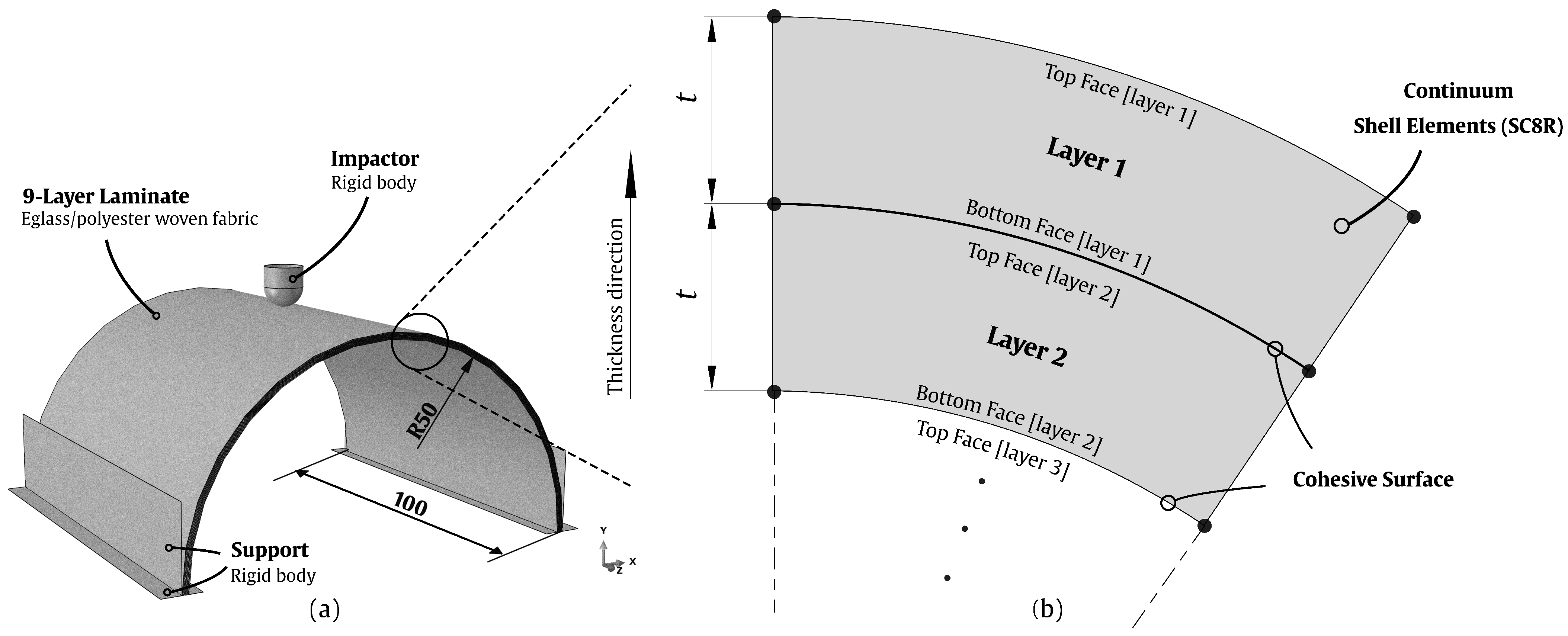


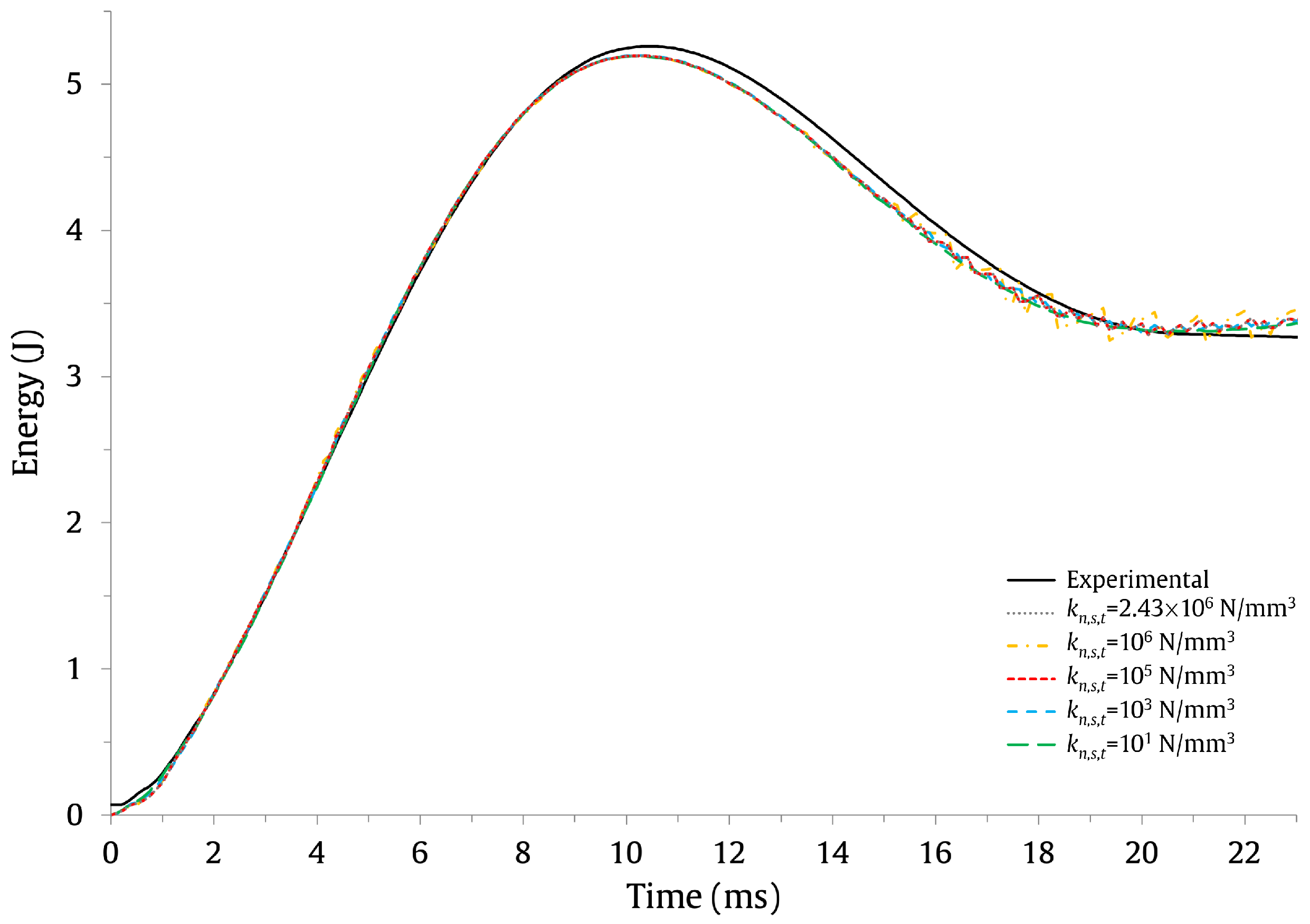

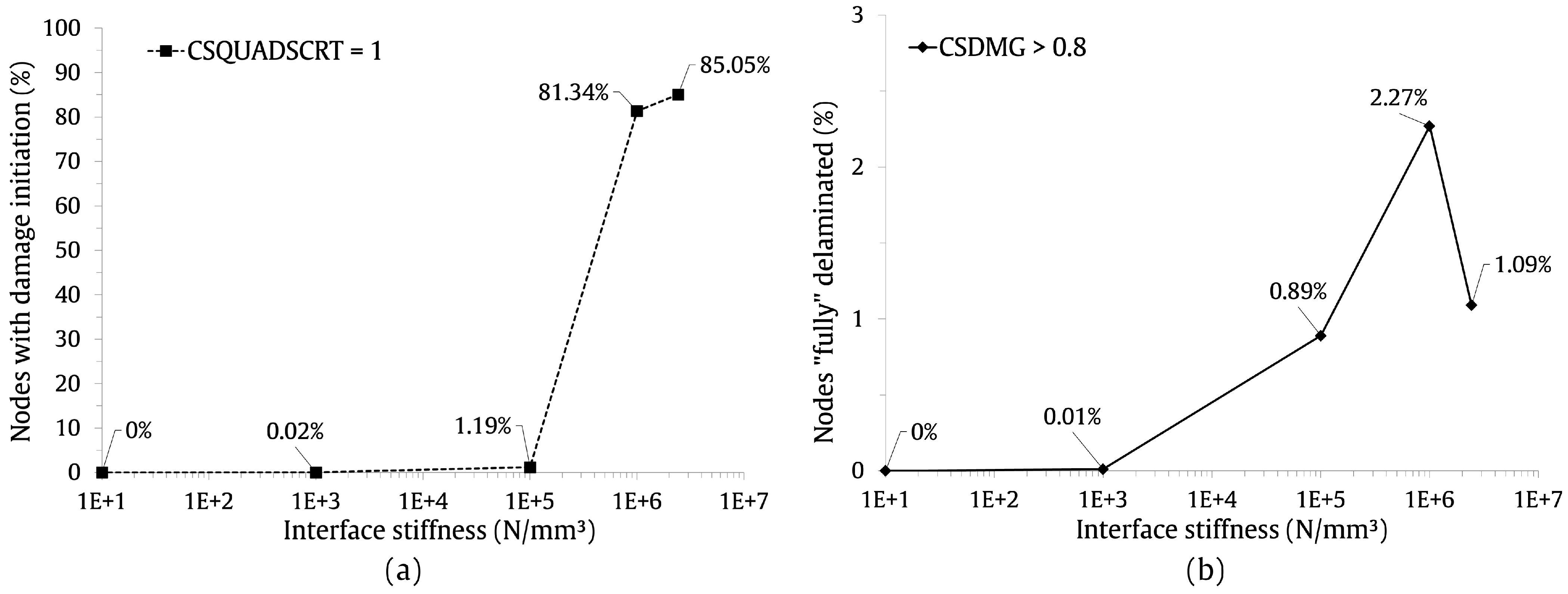

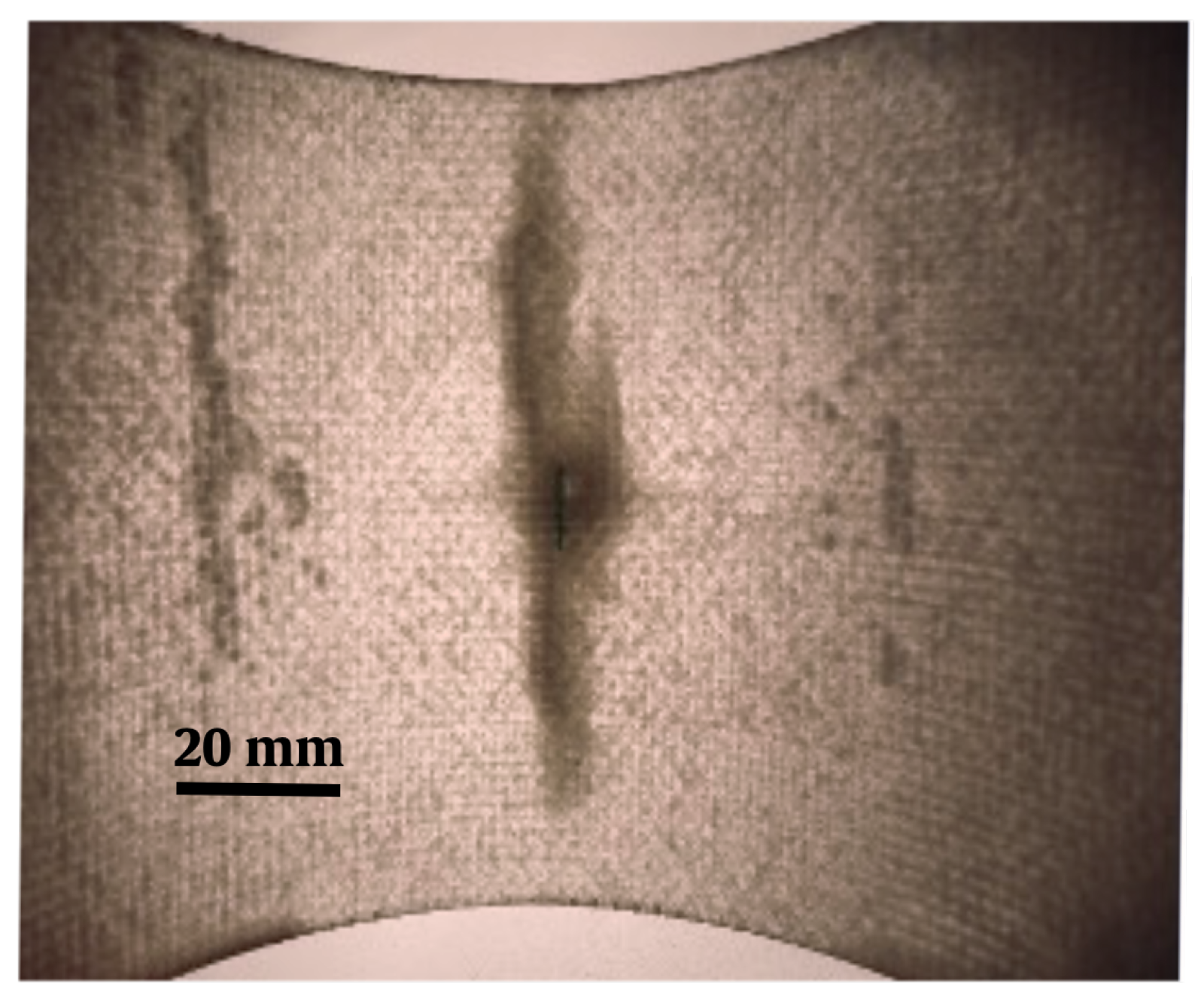

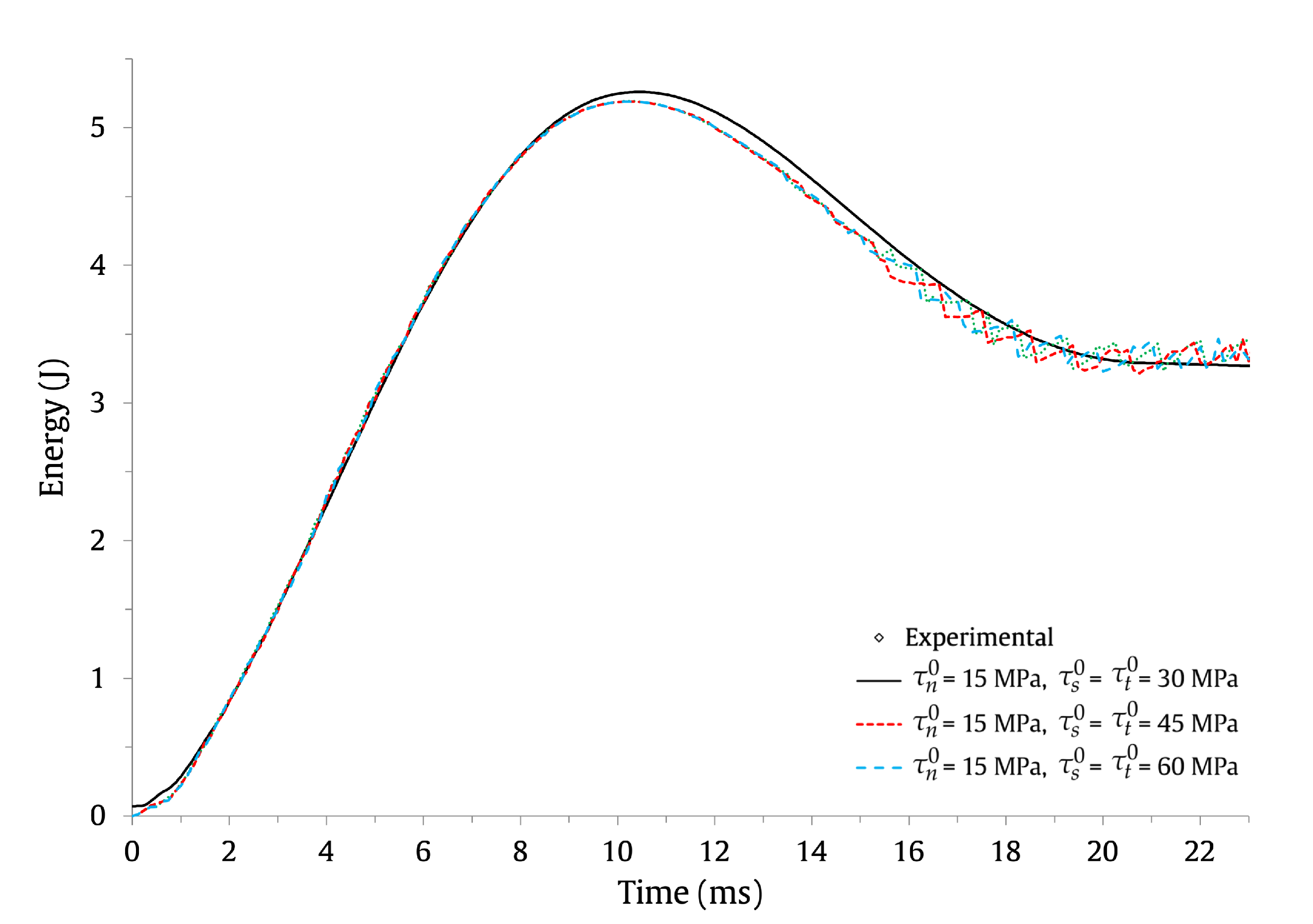
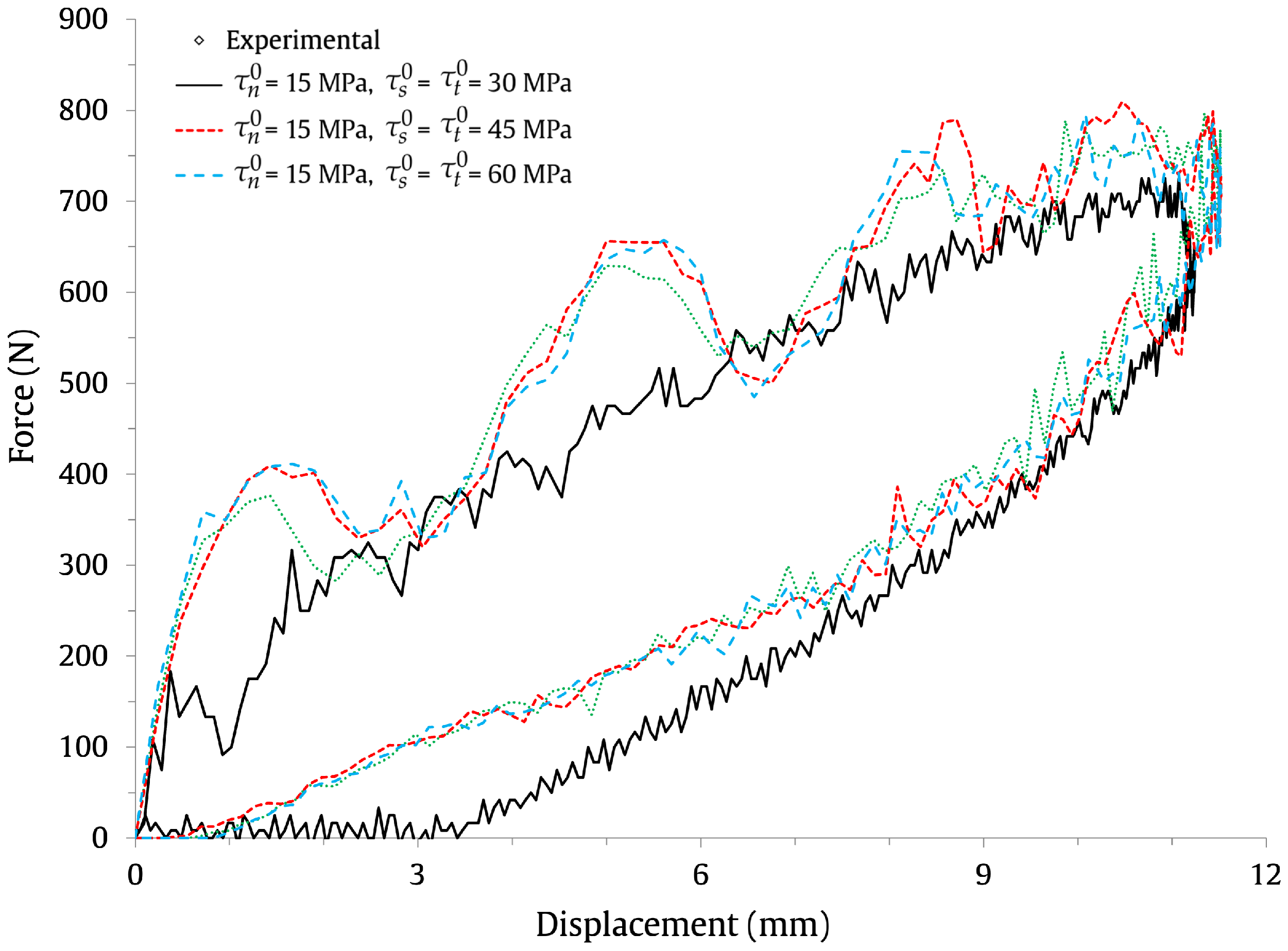
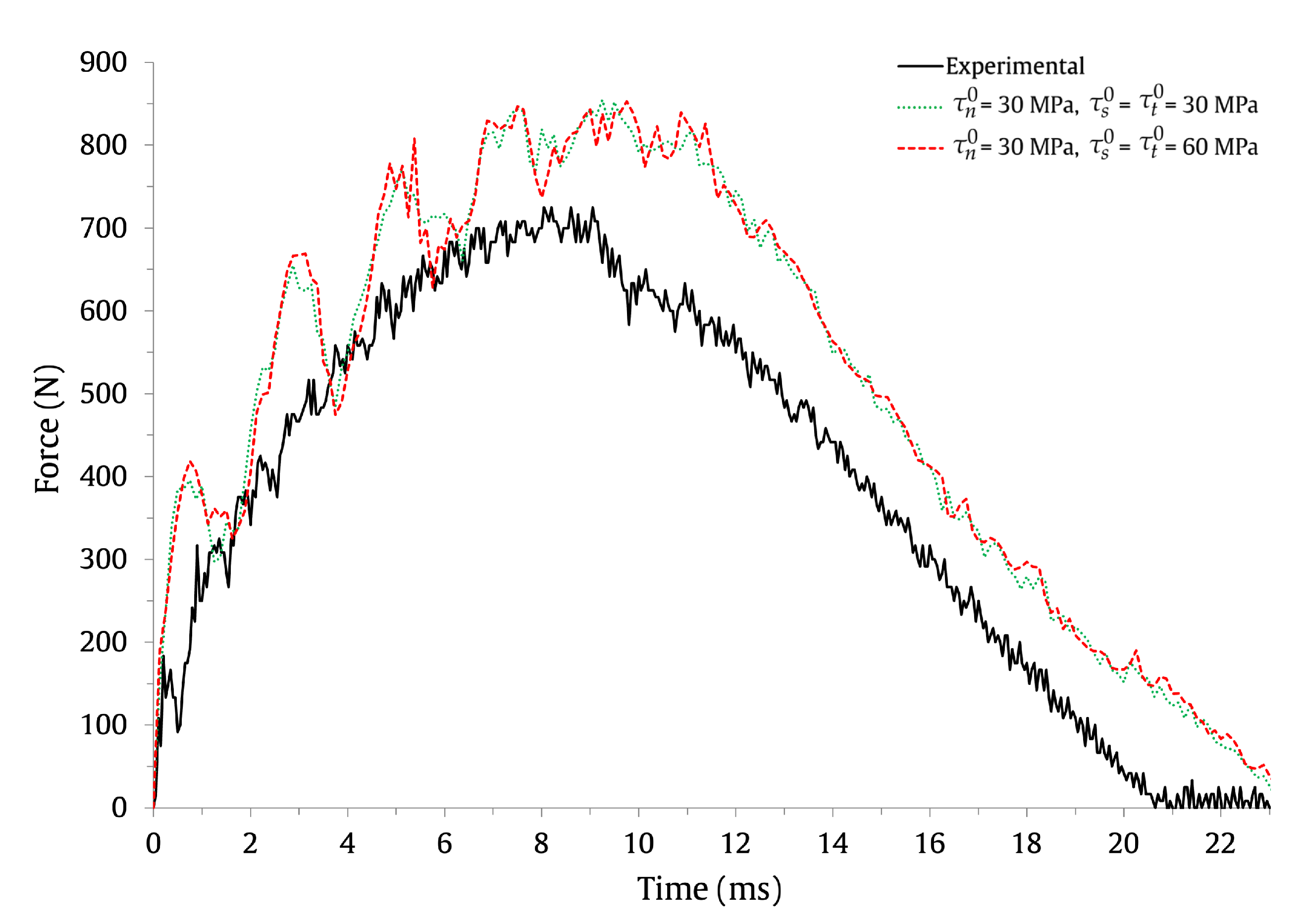
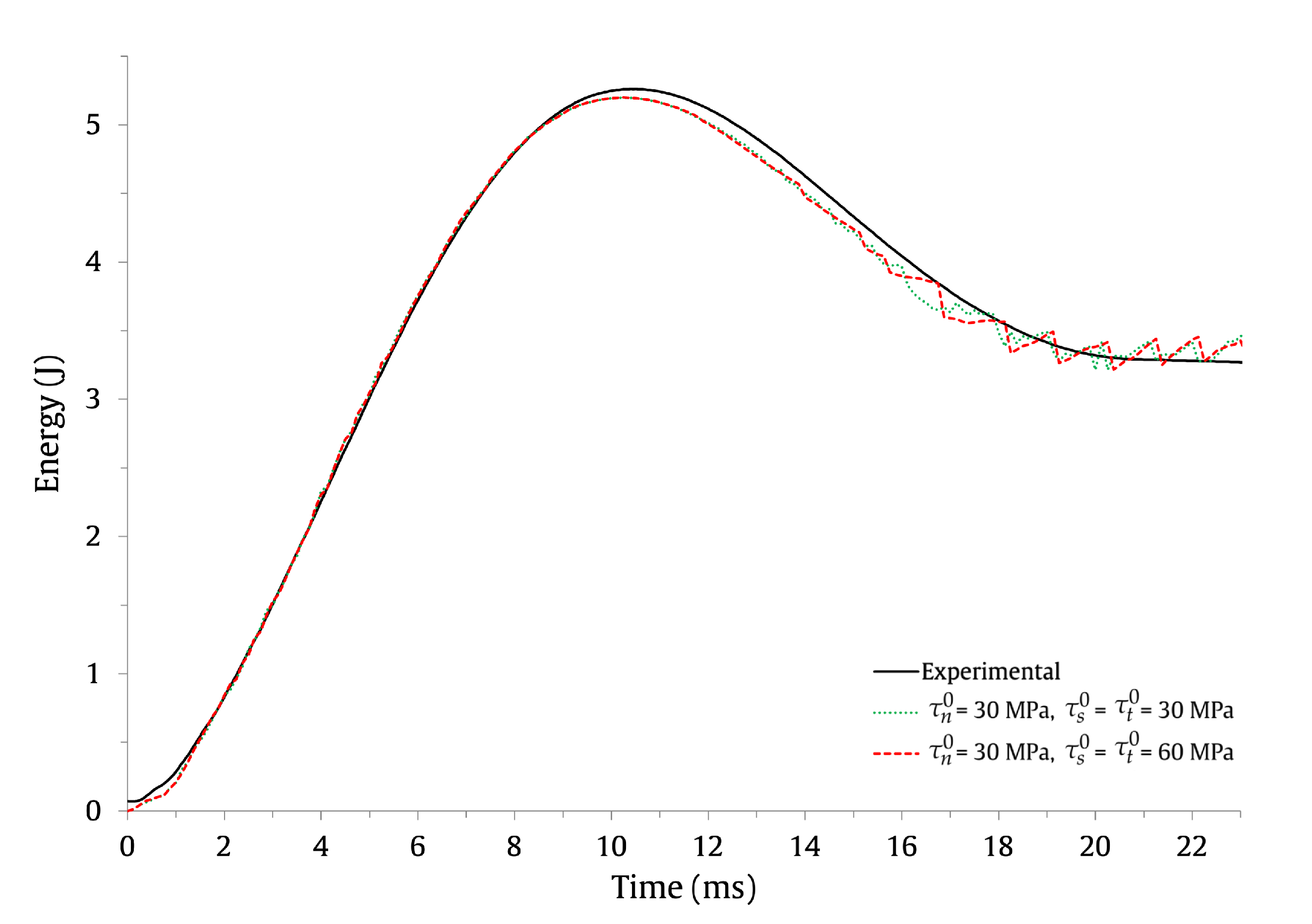

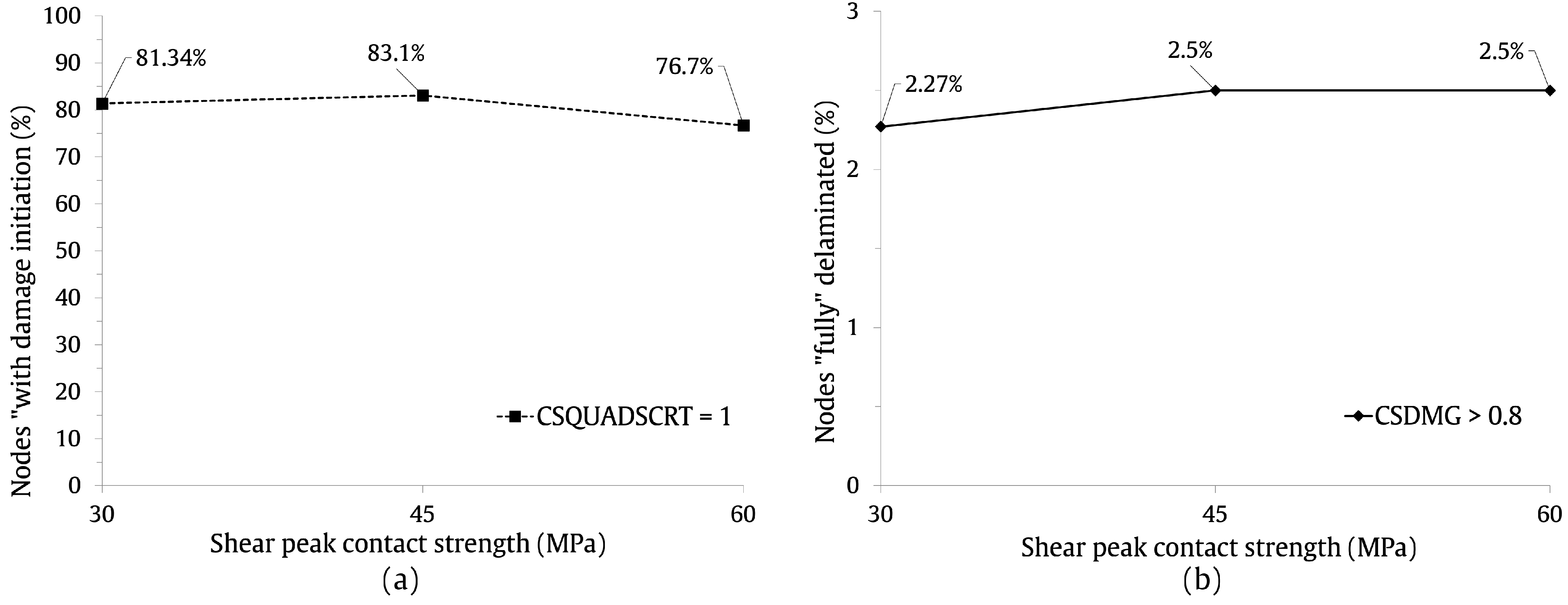


| Property | Symbol | Units | Value |
|---|---|---|---|
| Mass density | kg/m3 | 1900 | |
| Stiffness properties | GPa | 21.9 | |
| GPa | 8.6 | ||
| GPa | 3.4 | ||
| GPa | 2.4 | ||
| - | 0.14 | ||
| Strength properties | MPa | 250 | |
| MPa | 200 | ||
| MPa | 40 | ||
| Fracture toughness | N/mm | 4.5 | |
| Shear plasticity | - | 1 | |
| MPa | 25 | ||
| C | - | 800 | |
| p | - | 0.552 |
| Property | Symbol | Units | Value |
|---|---|---|---|
| Stiffness properties | N/mm3 | 10, 10, 10, 10 | |
| Strength properties | MPa | 15 (30, 45, 60) | |
| 30 (30, 60) | |||
| Fracture toughness | N/mm | 0.3 | |
| N/mm | 0.6 | ||
| - | 1.45 |
| Cohesive Stiffness () | Parameter |
|---|---|
| N/mm | 50 |
| 10 N/mm | 21 |
| 10 N/mm | 2.1 |
| 10 N/mm | |
| 10 N/mm |
Disclaimer/Publisher’s Note: The statements, opinions and data contained in all publications are solely those of the individual author(s) and contributor(s) and not of MDPI and/or the editor(s). MDPI and/or the editor(s) disclaim responsibility for any injury to people or property resulting from any ideas, methods, instructions or products referred to in the content. |
© 2023 by the authors. Licensee MDPI, Basel, Switzerland. This article is an open access article distributed under the terms and conditions of the Creative Commons Attribution (CC BY) license (https://creativecommons.org/licenses/by/4.0/).
Share and Cite
Ferreira, L.M.; Coelho, C.A.C.P.; Reis, P.N.B. Effect of Cohesive Properties on Low-Velocity Impact Simulations of Woven Composite Shells. Appl. Sci. 2023, 13, 6948. https://doi.org/10.3390/app13126948
Ferreira LM, Coelho CACP, Reis PNB. Effect of Cohesive Properties on Low-Velocity Impact Simulations of Woven Composite Shells. Applied Sciences. 2023; 13(12):6948. https://doi.org/10.3390/app13126948
Chicago/Turabian StyleFerreira, Luis M., Carlos A. C. P. Coelho, and Paulo N. B. Reis. 2023. "Effect of Cohesive Properties on Low-Velocity Impact Simulations of Woven Composite Shells" Applied Sciences 13, no. 12: 6948. https://doi.org/10.3390/app13126948








